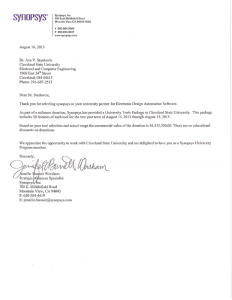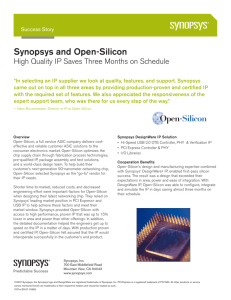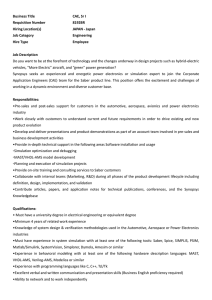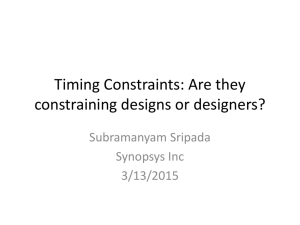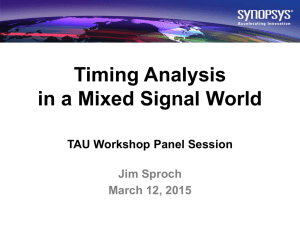Design, modeling, and optimization of silicon solar cells
advertisement
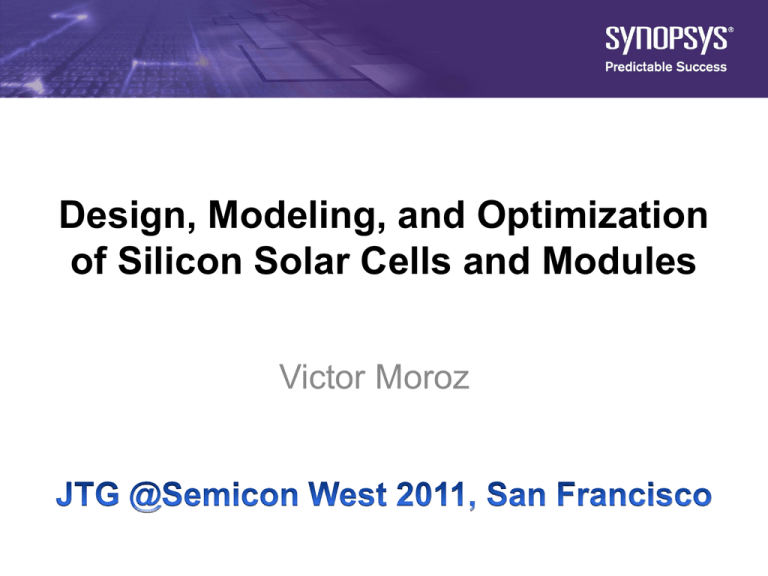
Design, Modeling, and Optimization of Silicon Solar Cells and Modules Victor Moroz © Synopsys 2011 1 Outlook © Synopsys 2011 2 Outlook © Synopsys 2011 3 PV System Challenges • • • • • Improving PV efficiency Optimizing for design performance and target reliability Reducing the effects of variation on system performance Predicting manufacturing yields Lowering production costs © Synopsys 2011 4 Addressing Issues at All Stages Cell Module Synopsys TCAD tools System Synopsys Saber tools Design criteria – Cell Level • Maximize efficiency • Optimize cell: contact pitches, junctions, anti-reflective coatings, etc. Design criteria – Module Level • Minimize effect of interconnects on performance • Minimize impact of cell variation or degradation on module performance Design Criteria – System Level • Maximize system performance accounting for diurnal solar inclination • Maximize system level efficiency delivered to the grid, including inverter system © Synopsys 2011 5 Why Simulate Solar Cells? Source: SERIS © Synopsys 2011 Early generation cell (Eff ~ 17%) 6 New generation cell (Eff > 20%) Solar Cell Simulation Flow Input Simulation Process Flow Recipe Process Simulation Texture Optical Data: n & k Electrical Data: SRH, Auger, BGN, Mobility Device Geometry (lifetime, doping profiles) © Synopsys 2011 7 Optical Simulation Electrical Simulation Output Texture Junctions External reflection Optical generation IQE, EQE Dark & Light I-V Outlook © Synopsys 2011 8 Solar PV Driving Force : $/W R&D cost ~ 1.5% (about 1.2GW shipment) (thousands) Net revenues $2,000,000 Cost of revenues $1,320,000 66.0% Gross profit $680,000 34.0% Operating expenses Cost = Watt © Synopsys 2011 9 Production cost ($) Output power (W) ~ SG&A $160,000 8.0% R&D $30,000 1.5% Total operating expenses $190,000 9.5% Operating income $490,000 24.5% Process Cost Conversion efficiency Efficiency vs Profit 26% p-type c-Si Conversion Efficiency (E) Lab 24% • Impact of DE = 0.5% 22% – E0=20% -> E=20.5% – DE/E0= 2.5% 20% Production 18% Pilot 16% • 2.5% more power output • 2.4% less cost per Watt • 2.4% more gross profit 14% 2008 2009 2010 2011 2012 2013 2014 2015 • 2.4% more gross profit = $1.32B * 2.4% = $32M1 • About the same as R&D budget ($30M ) 1Assume © Synopsys 2011 the same cost per unit module and wattage sales 10 Outlook © Synopsys 2011 11 Measured Texture © Synopsys 2011 12 Source: AMAT Simulated Surface Texture Zoom-in 20um * 20um surface © Synopsys 2011 13 Behavior of UV light (0.3um Wavelength) Bounced out ray Incoming ray Absorbed ray 12um • • • © Synopsys 2011 14 Absorption in Si happens within one micron from surface Typically one or two reflection events Only top surface matters Behavior of Visible Light (l=0.6um) Bounced out ray (reflectance) Incoming ray Absorbed rays 12um • • Bounced out rays (transmittance) © Synopsys 2011 15 Absorption in Si happens within tens of microns Several reflection events Behavior of Infrared Light (l=0.9um) Bounced out rays Incoming ray Absorbed rays 12um • • Bounced out rays © Synopsys 2011 16 • Absorption in Si happens within hundreds of microns Dozens of reflection events Both the top and the rear surfaces matter Reflectance Curves: Texture is Good 90.00 80.00 flat/flat textured/flat textured/textured Reflectance, % 70.00 60.00 50.00 bad 40.00 30.00 good 20.00 10.00 0.00 0.3 0.4 0.5 0.6 0.7 0.8 Wavelength, um © Synopsys 2011 17 0.9 1.0 1.1 1.2 Reflectance Curves: Nitride is Good 60.00 Reflectance, % 50.00 textured/textured textured+nitride/textured 40.00 30.00 20.00 10.00 Ideal! 0.00 0.3 0.4 0.5 0.6 0.7 0.8 Wavelength, um © Synopsys 2011 18 0.9 1.0 1.1 1.2 Model Accuracy 60 Textured Si, measured data 50 Textured+SiN, measured data Reflectance, % Textured Si, model 40 Textured+SiN, model • 30 20 10 0 0.95 1 1.05 1.1 1.15 1.2 Wavelength, um © Synopsys 2011 19 Si data from AMAT Calibrated model captures Si texture and nitride ARC film Outlook © Synopsys 2011 20 c-Si Solar Cell with Rear Point Contacts Rear point contacts (Al): Si-Al interface Front contact stripe (silver) © Synopsys 2011 21 Rear surface not covered by contact: Si-Nitride interface Rear Point Contact Optimization Doping Silicon quality Cell size Contact pitch … Increasing Rear Point Contact Area is GOOD! Current Crowding Contact Resistance Bulk Recombination Rear Point Contact Design © Synopsys 2011 22 Increasing Rear Point Contact Area is BAD! Optical Reflectivity Surface Recombination Rates Junction Optimization Junction depth … Higher doping in n layer is BAD! Higher doping increases recombination Higher doping in n layer is GOOD! Higher doping increases conduction Top Surface p-n Junction Design © Synopsys 2011 23 Modeling Major Effects • • • • • Optical Reflectivity Surface Recombination Contact Resistance Bulk Recombination Current Crowding Shaded area under top contact © Synopsys 2011 24 Current Crowding Pattern Current crowding is observed in both lateral directions, which makes it a 3D effect © Synopsys 2011 25 Rear Contact Optimization Best design with > 1% efficiency advantage solar cell design with full backside coverage © Synopsys 2011 26 Junction Optimization Resistance 22.0 Recombination Cell Efficiency (%) 21.0 20.0 Xj=0.1um Xj=0.2um Xj=0.4um Xj=0.6um Xj=0.8um Xj=1.0um 19.0 18.0 17.0 16.0 1.E+18 Shallow junction Deep junction 1.E+19 1.E+20 Peak Doping Concentration (cm-3) © Synopsys 2011 27 1.E+21 Junction Optimization Improved junctions 22.0 Cell Efficiency (%) 21.0 20.0 19.0 Industry standard POCl junctions Xj=0.1um Xj=0.4um 18.0 Xj=0.6um 17.0 Xj=0.8um 16.0 1.E+18 1.E+19 1.E+20 Peak Doping Concentration (cm-3) © Synopsys 2011 28 1.E+21 Outlook © Synopsys 2011 29 System Integration & Optimization • Simulation provides integrated test, validation and optimization environment for all aspects of the system: Environment Power Electronics Control System & Algorithms © Synopsys 2011 30 Modules to Arrays and Systems • Design problem: Thermal Effects on Module/Array performance and Maximum Power Point • Analysis of faults on strings within the array © Synopsys 2011 31 Photovoltaic Module Performance Verification at Different Cell Temperatures Measurement of MPPT at Different Temperatures Summary © Synopsys 2011 32

